It’s finally here: the flight review you’ve all been waiting for.
Back in November, I had the incredible opportunity to fly on the Beechcraft 1900D on my cross-country hopper journey across Canada.
Air Canada Beechcraft 1900D – Booking
The Beechcraft is one of the most exclusive experiences in commercial aviation, with only 18 seats in its intimate single cabin, spread across nine rows in a 1-1 configuration. I booked this flight as part of one-way Aeroplan booking across Canada for 25,000 miles in business class.
Indeed, it’s a flight experience so coveted that Air Canada even excludes the Beechcraft entirely from the Our Fleet page on its website, leaving only those who are “in the know” to compete for one of the aircraft’s 18 seats.
And to push its exclusivity even further into the realm of the Air France La Premières and Etihad Residences of this world, the “Beech”, as it’s affectionately known within aspirational puddle-jumping circles, is only available on a select handful of Canadian routes, such as Cranbrook–Calgary, Gander–Deer Lake, and the route for which I had taken a massive detour into the Maritimes tonight: Saint John–Halifax.
I was determined to try out a flight on the Beech for myself, so the fact that I was somehow taking a 44-minute hop across the Bay of Fundy, as part of a one-way journey from Vancouver to Toronto, made absolutely perfect sense… as did the fact that Aeroplan actually lets you book a trip like this as part of a single award ticket!
Air Canada Beechcraft 1900D – Ground Experience
I had about four hours to kill in the glamorous surroundings of Saint John Airport before my flight on the Beechcraft 1900D would be departing at 8:35pm.

Saint John Airport

Saint John Airport
Economy class passengers departing from Saint John are invited to relax at the Connections Bistro, where guests can enjoy a complimentary tap water, as well as burgers, wraps, smoothies, coffee, and beer for a price.
Happily, there were also individual power and USB outlets available at each seat in the restaurant, allowing me to get some work done during my layover.
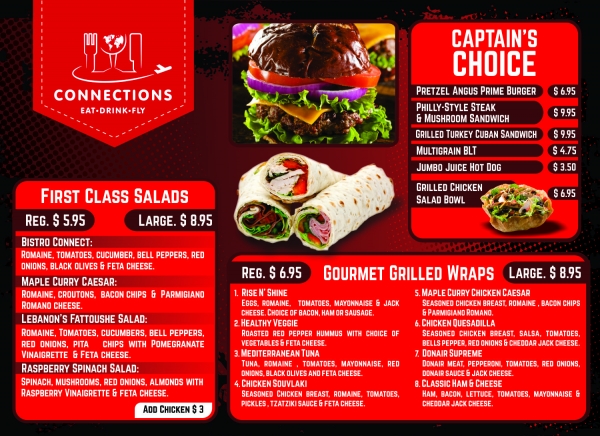
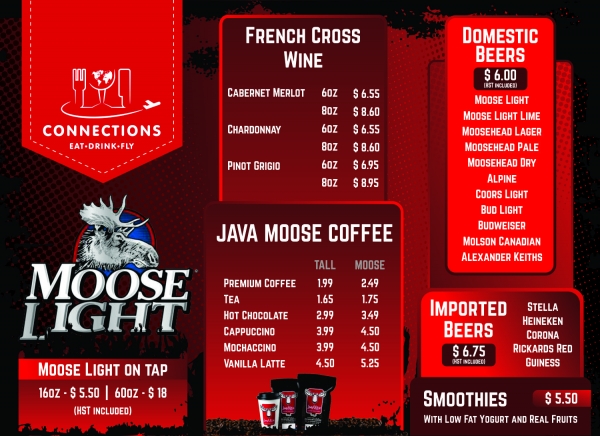
At about 6pm, an Air Canada associate approached me in the restaurant to hand-deliver a very special pre-departure item: my passport! Turns out, I had left my passport in the seat-back pocket on my earlier flight from Montreal before dozing off for the rest of the flight, and I didn’t remember to bring it with me when disembarking.
The crew ended up finding it while preparing the cabin for the next flight, and by looking at my itinerary, the Air Canada staff figured out that I was one of the lucky few to have secured a seat on that night’s Beechcraft service to Halifax, so they knew I couldn’t have ventured too far.
Scanning the departure hall for the only face that could possibly be surnamed “Zhang”, the staff member was able to reunite me with my travel documents, and I was very grateful indeed.
An hour later, I stood up to approach the Air Canada check-in desk to get ready for the flight, and came face-to-face with the very same Air Canada associate once again. As he printed my boarding pass, the ink barely drying on that coveted flight number of Air Canada Flight 7766, he flashed a knowing smile that hinted at the incredible experience that lay ahead, and said: “Enjoy your flight sir.”
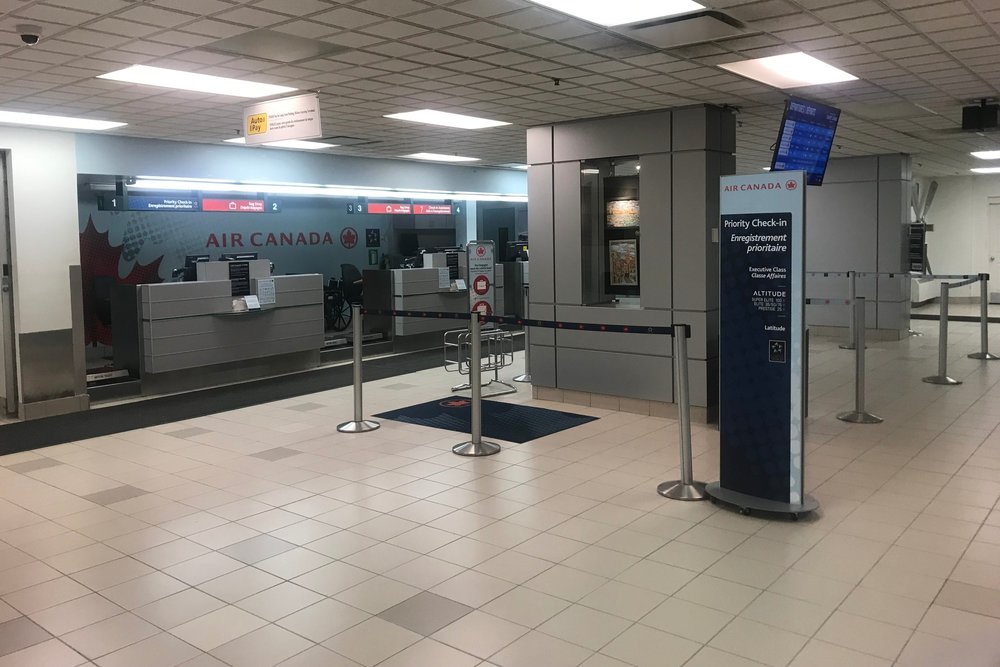
Saint John Airport – Air Canada check-in
That was indeed the plan, and I could barely contain my excitement as I headed towards the security checkpoint. As if sprinkle even more fanfare on my maiden Beechcraft flight, I was delighted to see that our flight tonight would be departing from Gate 1 – prime real estate here at the heavily slot-restricted Saint John Airport, of course.
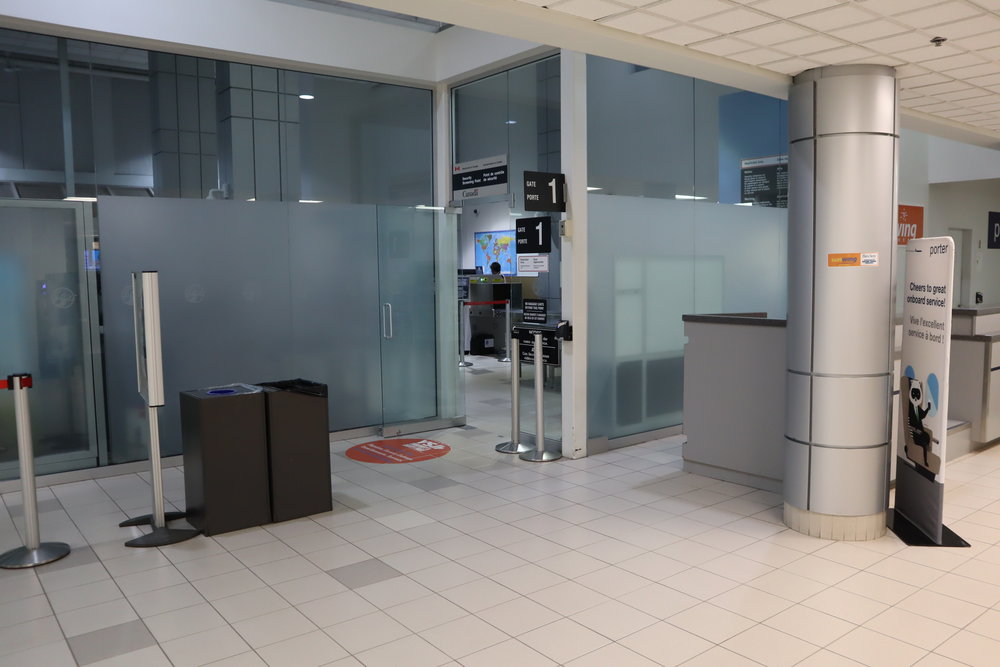
Saint John Airport – Security checkpoint
As Canada’s oldest chartered city, Saint John’s been attracting tourists to this corner of New Brunswick since well before Toronto ever came to be widely regarded as the centre of the universe.
As a result, the city’s airport can get rather busy at peak hours, with the Air Canada and Porter flights shuttling people in and out of the region (and the seasonal Sunwing flight to Varadero also proving popular with the significant Acadian diaspora in Northern Cuba). But thankfully, on a Thursday night and with only the Beech service to Halifax as the last remaining flight of the day, the security queue was virtually empty, and I shuffled through in no time.
In comparison to the snacks and treats available at the landside Connections Bistro, the airside waiting area was relatively bare-bones. There was a market and duty free store, which I was disappointed to see was closed at this hour.
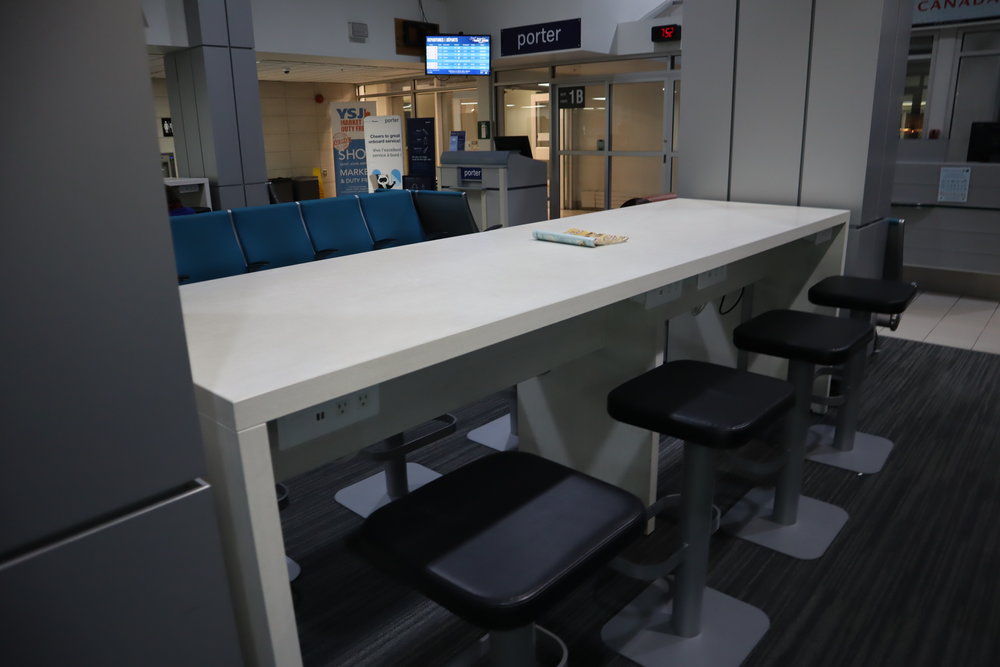
Saint John Airport – Airside waiting area
The only other feature in the waiting area was a set of restrooms, which the gate agent went over the loudspeaker to encourage all of us who would be boarding Flight 7766 to make use of prior to our flight, since there wouldn’t be any restroom facilities on the Beechcraft itself.
It’s unbelievable the lengths that airlines will go to in order to cut costs these days, isn’t it?
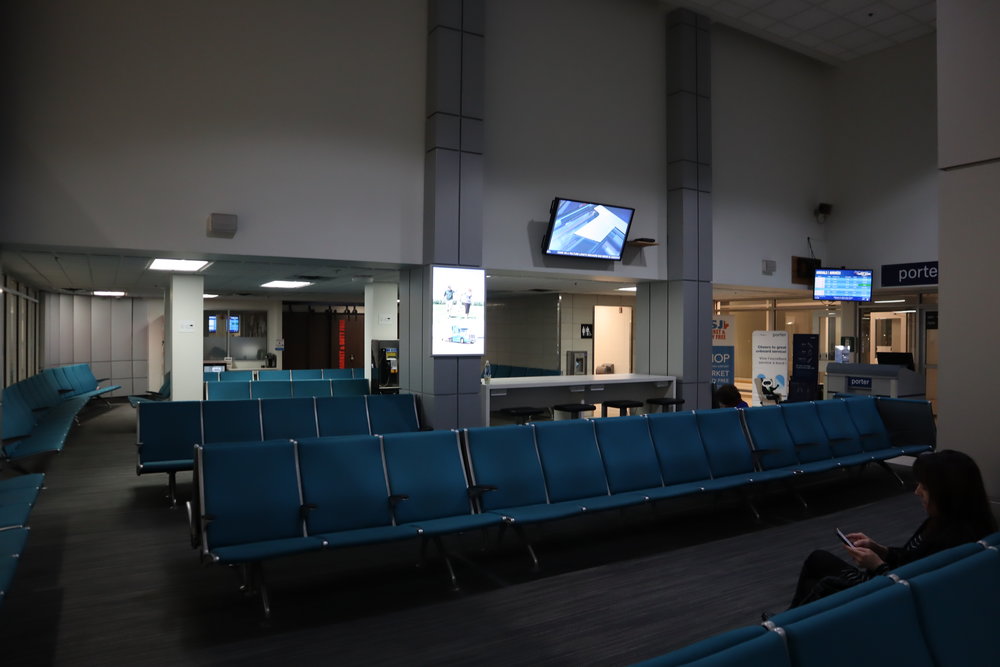
Saint John Airport – Airside waiting area
Even though our departure time was scheduled for 8:35pm, it seemed that the Air Canada staff at Saint John wanted to call it an early night, since they announced boarding would begin as soon as the passengers from the previous flight deplaned at about 7:50pm.
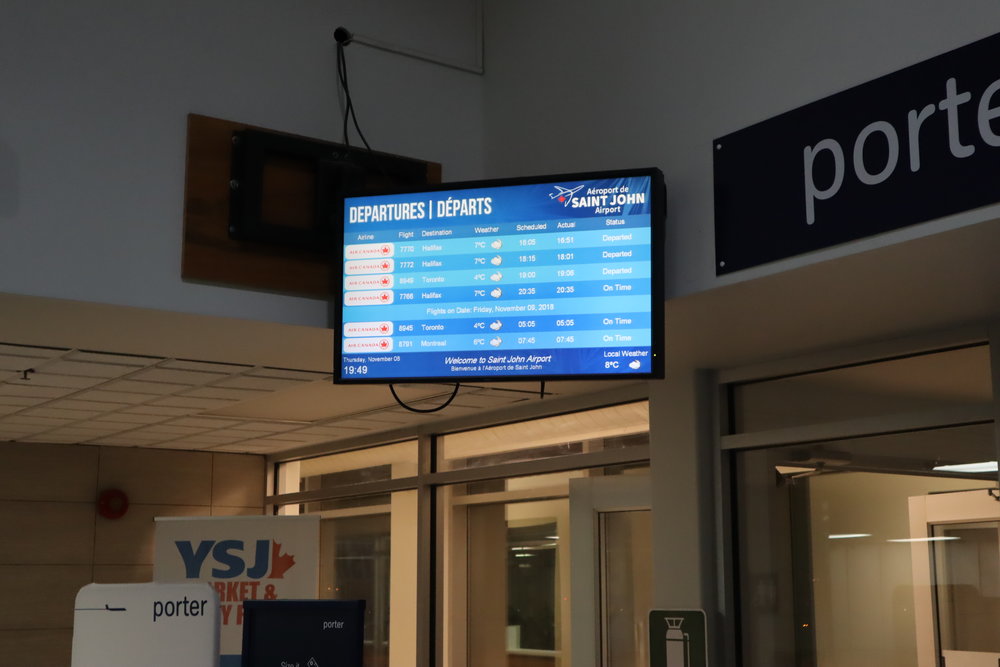
Saint John Airport – Departures board
Naturally, I couldn’t miss the opportunity to grab some shots of the aircraft cabin, so I was first in line to scan my boarding pass and make my way across the tarmac.
And there it was, in all its glory: the Beechcraft 1900D – decked out in the stylish livery of Exploits Valley Air Services (EVAS), the regional airline that operates the flight on behalf of Air Canada – which would be my home for the next 44 minutes.
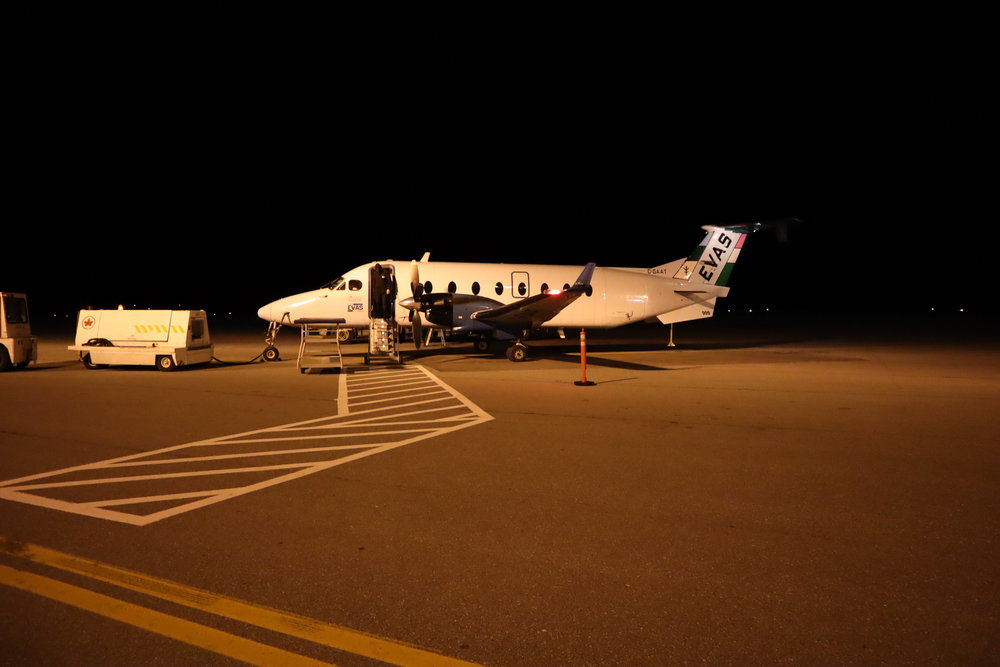
The Beechcraft 1900D
Approaching the airplane and admiring it closely – the distinctively pointed shape of the nose, the sleek white body of the plane and the eye-catching tailfin, the nine windows with a single overwing emergency exit – I couldn’t help but marvel at how different this flight would from any other flight I’ve taken in the past.
It felt like both a toy plane and a private plane at the same time. A private toy plane, perhaps?
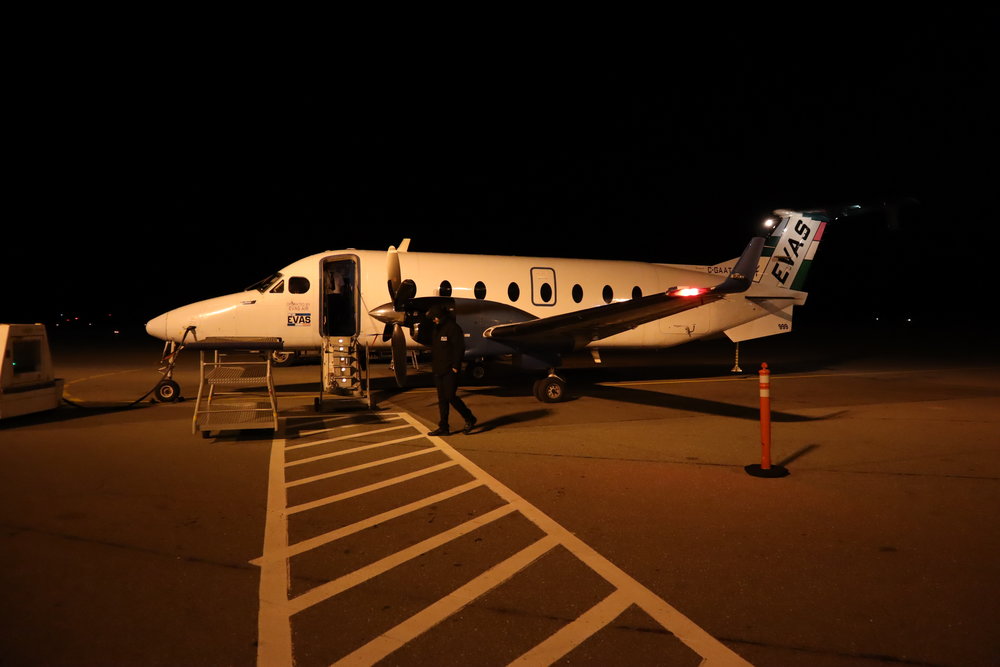
The Beechcraft 1900D
As I made my way up the steps, I was greeted by whom I thought was going to be the in-flight service manager. I remarked to myself that the guy’s uniform, a black zip-up hoodie with the EVAS logo embroidered on it, was very casual for an airplane cabin crew, perhaps reflecting the laid-back disposition of the wider Atlantic Canada region where EVAS primarily operates.
Air Canada Beechcraft 1900D – Cabin
I turned right into the main cabin of the Beechcraft, where I was greeted by the sight of nine rows of seating that looked… well, pretty much exactly as I had expected it to. Tight, cramped, and dark.
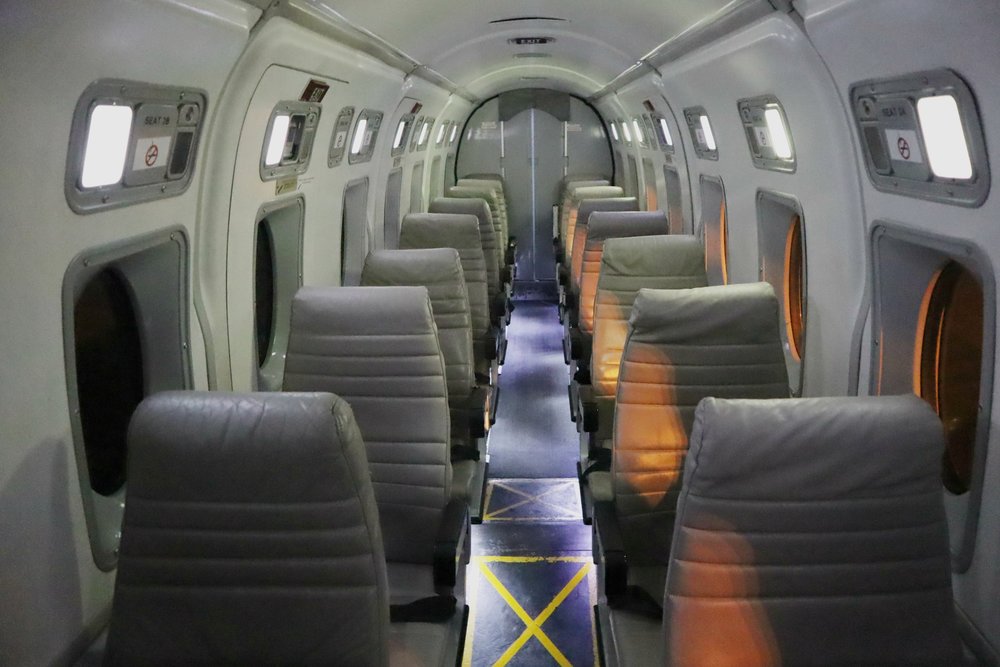
Air Canada Beechcraft 1900D – Cabin
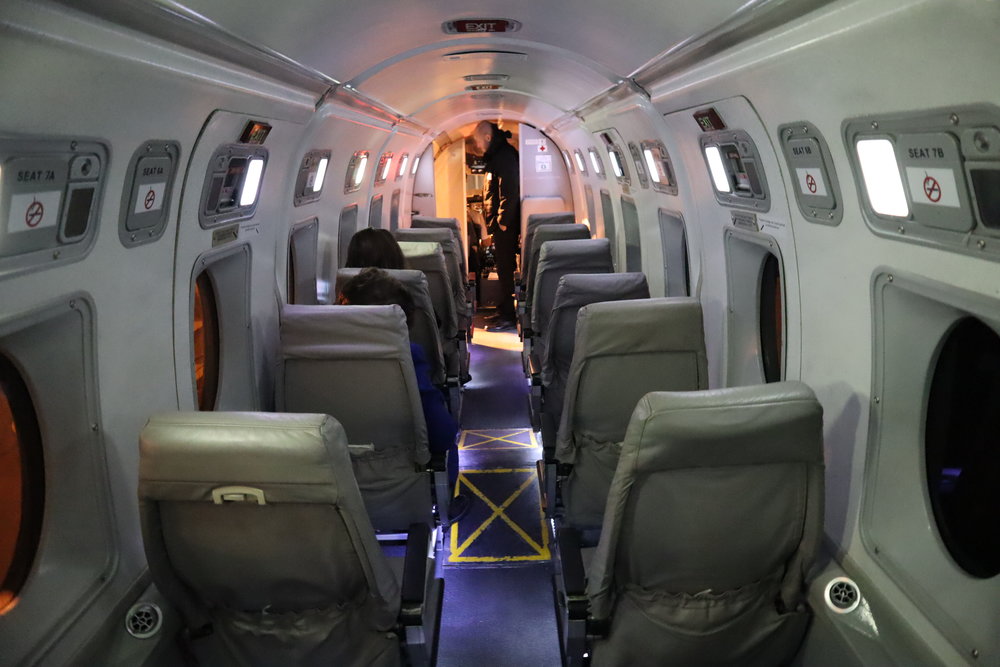
Air Canada Beechcraft 1900D – Cabin
Every seat is virtually identical, with relatively little wiggle-room in terms of both the pitch and the width of the seat. The Beech is clearly all about style over substance, though, with the cabin finishes going for that classic “throwback to the 1920s” look, striking a particularly drab balance somewhere between grey and beige.
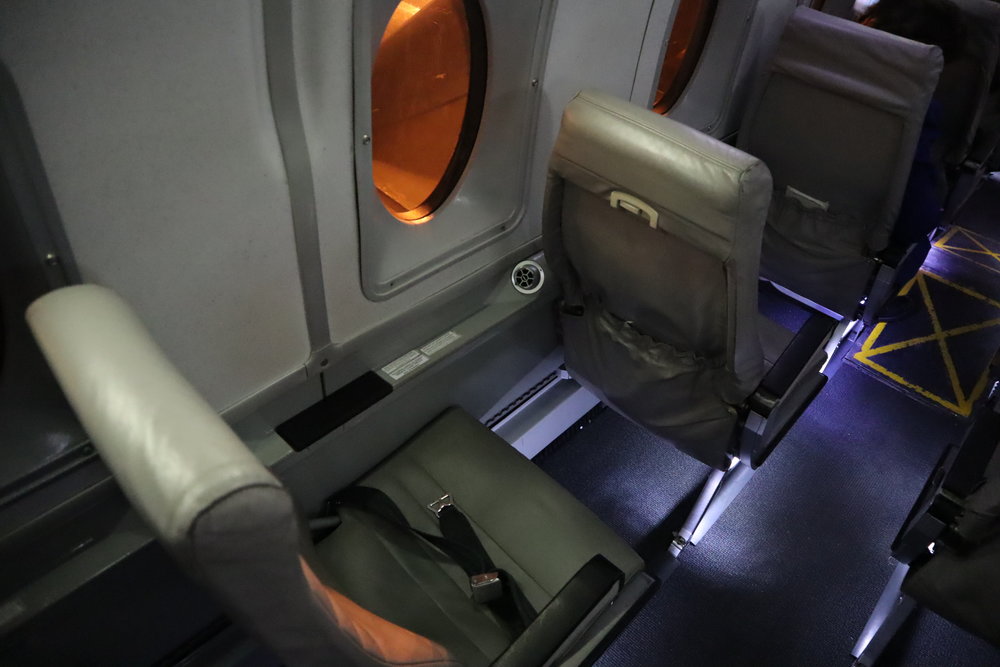
Air Canada Beechcraft 1900D – Seats

Air Canada Beechcraft 1900D – Seats
In terms of seat selection, I’d recommend avoiding the seats in Rows 4 and 5 in particular, which are perched on top of a small groove in the floor of the aircraft that further encroaches upon your personal space.
Rows 6 to 9 towards the back of the plane are perfectly good choices, but the real winners are the seats towards the front in Rows 1 to 3 (with Row 1 in particular offering the most legroom). That’s because, as I was soon to discover, the lack of a cockpit door in the Beechcraft means that you get to crane your neck and look directly out of the cockpit window!
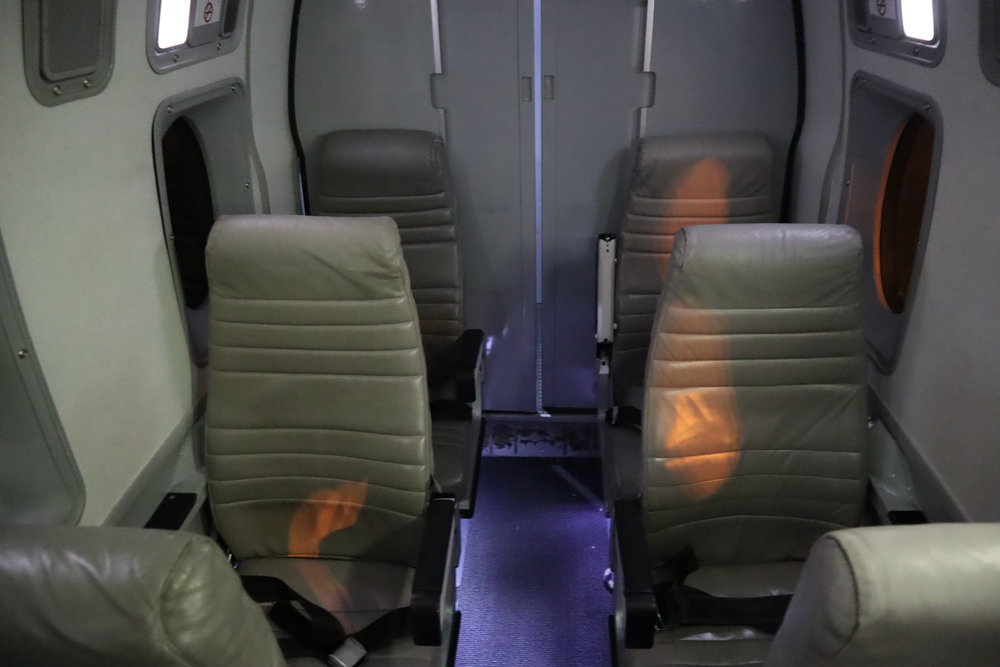
Air Canada Beechcraft 1900D – Rows 8 and 9
Air Canada Beechcraft 1900D – Seat
Whenever I have the pleasure of trying out a new airplane seat, the first thing I do is play around with all the seat features, and this flight would be no exception.

Air Canada Beechcraft 1900D – Seat 3A
As I settled into Seat 3A, I placed my backpack under the seat in front of me (there are no overhead bins, so any larger baggage goes into the hold)…
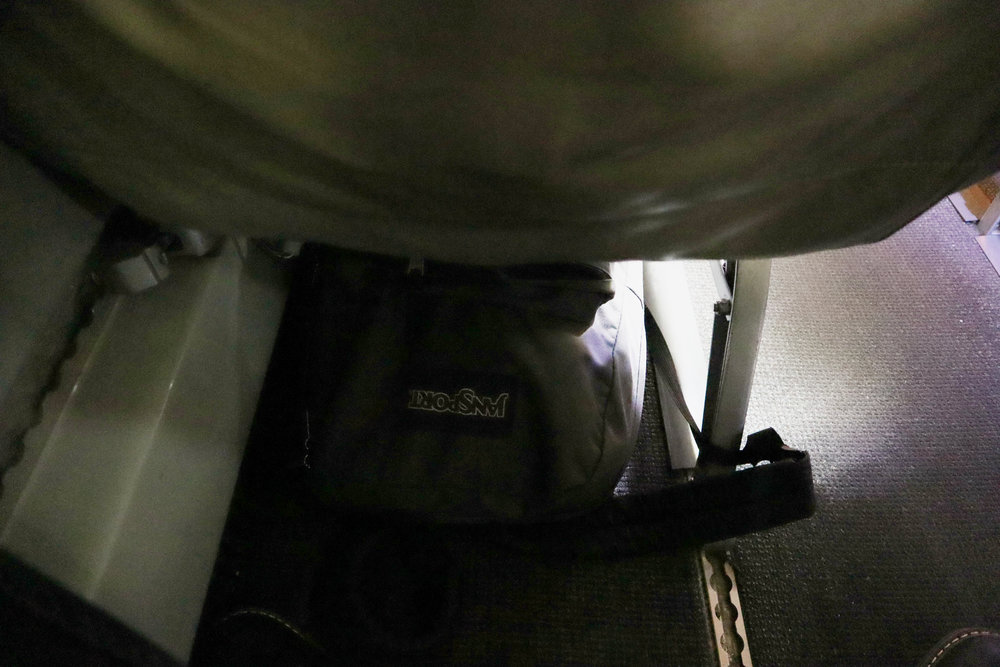
Air Canada Beechcraft 1900D – Under-seat storage
…and I fiddled with this little circular contraption that was located at each seat, which seemed to resemble either a light or an air nozzle, but functioned as neither…
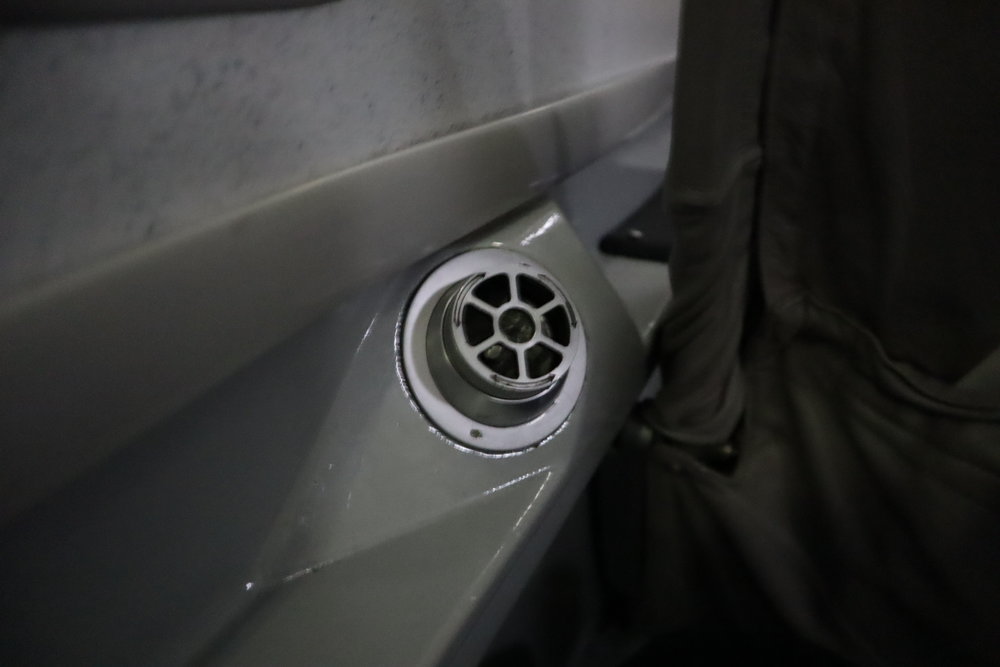
Air Canada Beechcraft 1900D – Mysterious contraption
…and that was about it. There were no more seat features.
Four other lucky souls were booked on this flight, and pretty soon we had all taken our seats, and the boarding process was complete. At this point, the guy whom I thought was a crew member took his place in the cockpit alongside the captain, and only then did I realize he was in fact the first officer for the flight.
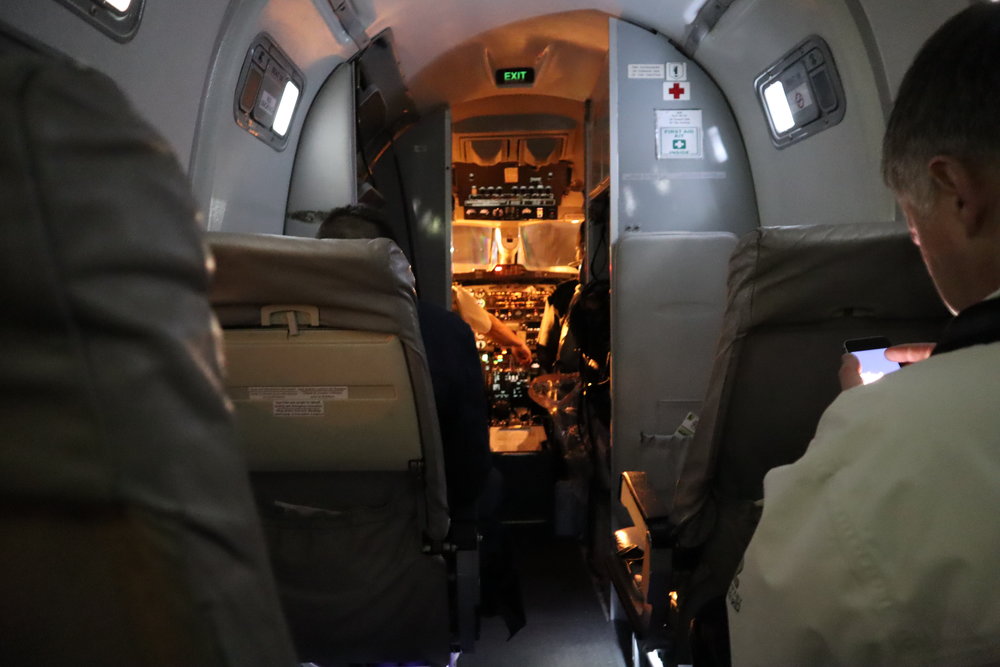
Air Canada Beechcraft 1900D – View from Seat 3A
Air Canada Beechcraft 1900D – In-Flight
The captain took to the PA to announce our flight time of 30 minutes and a cruising altitude of 12,000 feet. Needless to say, I felt a little short-changed by the fact that the 44 minutes of flying time on the Beechcraft that I was promised would be slashed by almost a third.
With no other aircraft occupying the runways of Saint John Airport and only five passengers on the manifest, there was little in the way of pre-departure fuss, and we were taking off and airborne by 8:10pm, well before the published departure time of 8:35pm.
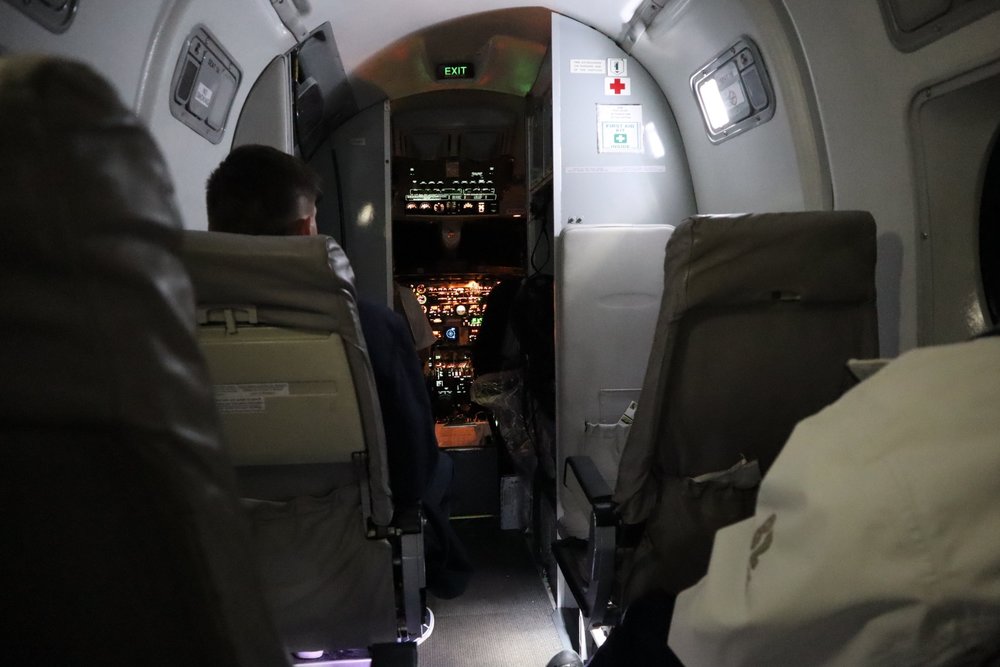
Air Canada Beechcraft 1900D – Taxiing Saint John Airport
The captain also announced that he’d be turning off most of the cabin lights entirely for the duration of the flight, leaving only a single beacon of light to illuminate the plane, and severely hampering my efforts to take photos for the remainder of the journey.
It’s my understanding that the Beechcraft 1900D actually does have sliding doors at the cockpit, but that many crews choose to leave the doors open and provide passengers with an open view of the flight deck. Our captain was feeling generous, leaving the doors open for the entirety of the flight, and I found myself transfixed by the sight of the pilots doing their thing as we made our way to Halifax.
(And yes, I did wonder how easy it would be for a Beech to be hijacked by unscrupulous actors, and I’m probably on a list somewhere now for saying that.)
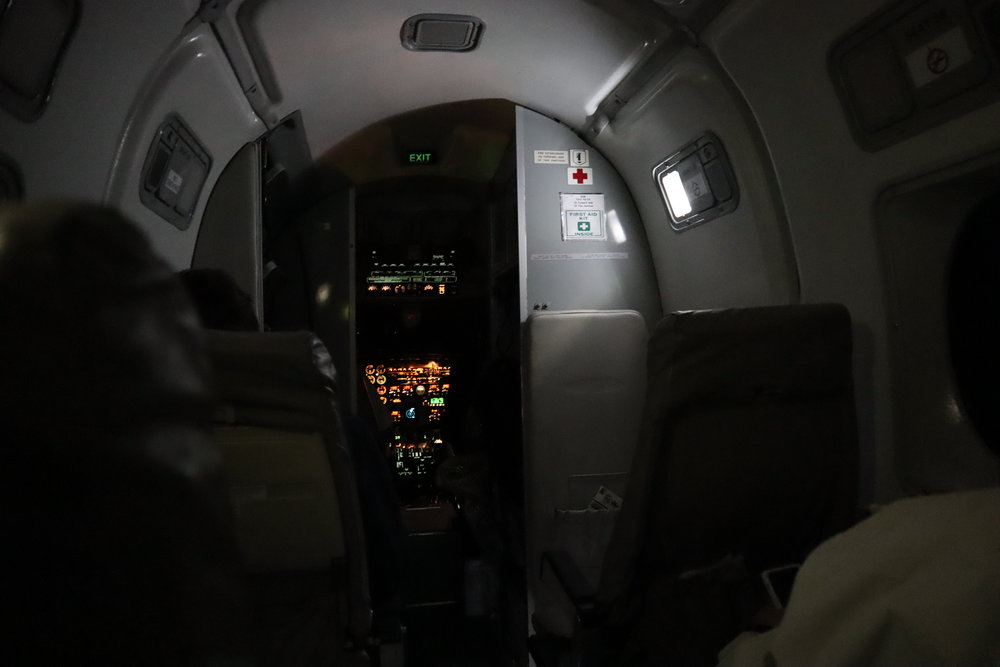
Air Canada Beechcraft 1900D – En route to Halifax
Rather disappointingly, though, there were no views to be enjoyed through any of the windows, because… well, it was pitch black outside.
“Son of a Beech,” I thought to myself, “What on earth was I thinking when I booked this flight?”
One thing’s for sure – if I’m ever lucky enough to fly the Beech again, I’ll definitely be booking a daytime flight in order to enjoy the full splendour of the cockpit window views.
Nevertheless, the open views of the cockpit controls were enough to leave my eyes glued to the front of the plane for most of the flight. It was a rather windy night in the Maritimes, and the merciless wind took our bird for a few turbulent bumps and drops throughout the flight. It also conspired with the inadequate lighting to make it nigh-on impossible for me to take photographs, so eventually I just put my camera away and sat back to enjoy the ride.
After 30 minutes of flying through the blackness of night, the runway lights of Halifax Stanfield International Airport slowly came into view. Despite plenty of wind shear during our approach, which at times tilted the plane at seemingly precipitous angles, I watched all the way as the captain guided us to a safe landing.
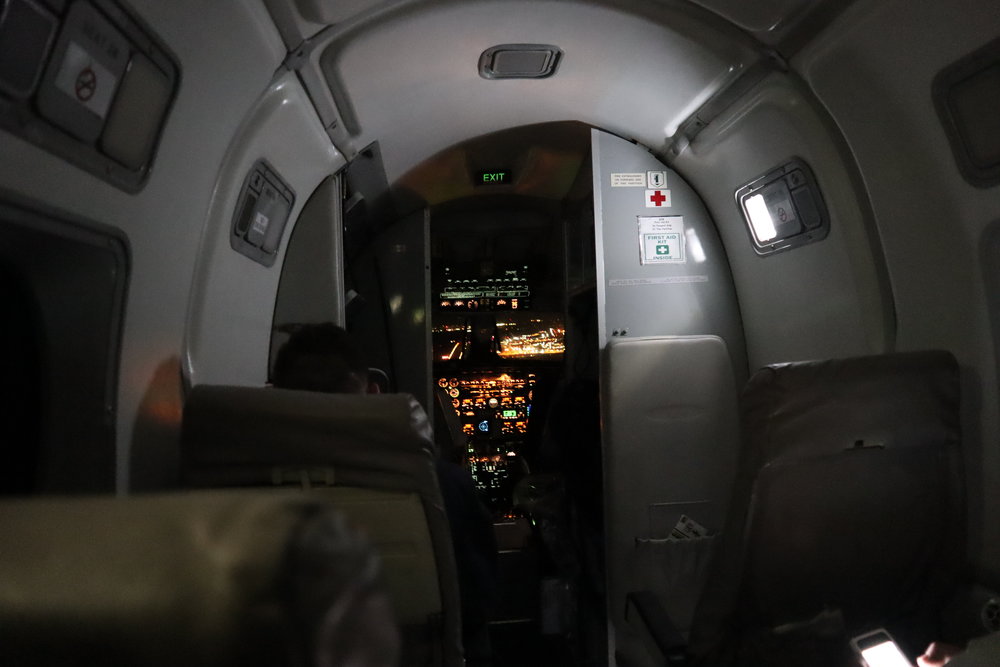
Air Canada Beechcraft 1900D – Approach to Halifax
After a quick taxi to our remote stand, we shuffled off the plane one-by-one, hunching our backs to avoid hitting our heads on the ceiling.
First Officer Zip-up Hoodie assumed his position by the door to bid each of us goodbye, and from there, I walked across the tarmac to the main terminal of Halifax Stanfield, turning back one last time to gaze at the beautiful bird that had given me these unforgettable 30 minutes in the air.
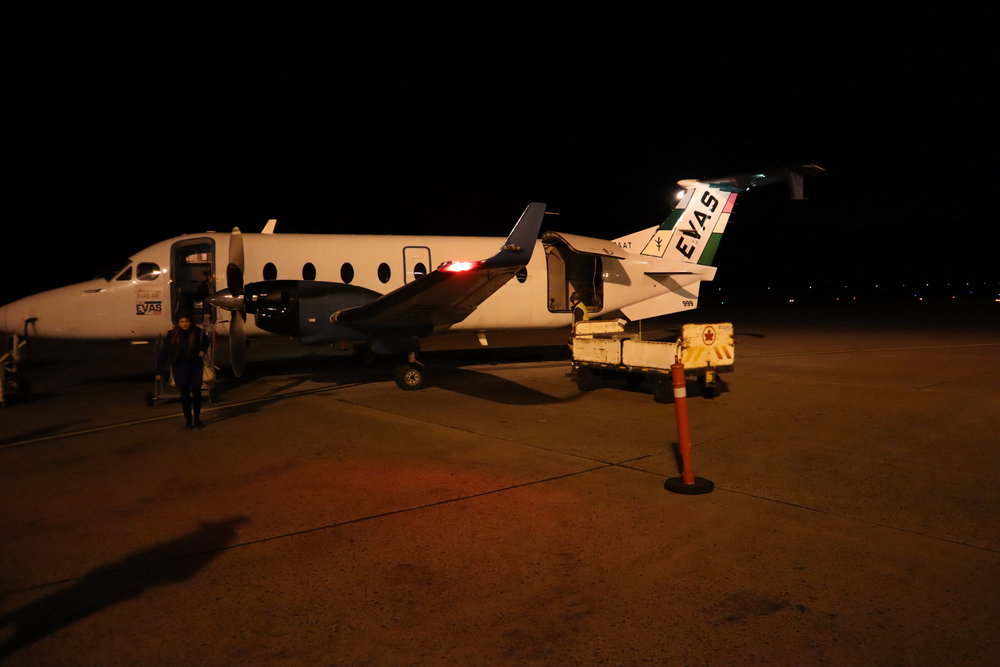
Bye Beech.
Conclusion
I hope you enjoyed today’s slightly off-kilter flight review. 😉 The Beechcraft 1900D is a very unique aircraft to fly on – tiny, loud, and cramped, like flying on an artifact from World War II – and it’s something of a novelty item for aviation geeks.
It’s mainly used to serve some of Canada’s smaller communities, and is operated by Air Canada’s regional subsidiaries of Air Georgian and EVAS, as well as independent airlines like Pacific Coastal Express and Central Mountain Air. If you’re an aviation geek in any capacity and would like to try it out, the truth is that the Air Canada’s Beechcraft fleet is slowly being phased out, so I’d recommend checking it off your bucket list sooner rather than later!


















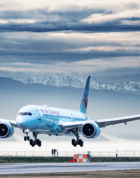


Doesn’t it have 8 cabin windows? Was there a lavatory at the rear?
No lavatory on this one. Some airlines choose to configure the Beechcraft with a rear lavatory, but not EVAS in this case.
I actually just flew on this plane from Moncton to Halifax in the same seat! Mine was an afternoon flight so I got the luxury of watching the ground slip by for about 30min
Glad to hear our Beeches are still out there jumping puddles!
Don’t worry Ricky, I picked up on the sarcasm but an interesting change of pace from some of the more magnificent experiences you’ve racked up… trying to catch up by diving deep on your manufactured spending pieces
Wow! This review was AH-MAZING! hahaha
I fly this aircraft YXC – YYC somewhat frequently, and it does have a certain nostalgia to it so I enjoyed this read and your appreciation of the experience!
Too bad they’re abolishing that specific route (among others).
I was lucky enough to fly this a few times as Air Canada used to fly them from Toronto to Detroit about 5 years or so ago on certain frequencies. It’s a great flight if you truly love flying as you feel every bump, turn and gust of wind and of course the view out of the cockpit. Lots of fun!
Don’t get me wrong… this is a neat plane… but I guess it doesn’t seem that special on the west coast… as plenty of teeny float planes fly back and forth all day between Vancouver and Victoria… other than being small… what makes it more special than, say, flying with a friend in a Cessna?
Is it just a "tick it off the list" kind of plane? I’m honestly curious, btw.
Yep, that’s pretty much it. A novelty item for someone like me who doesn’t get to fly in small planes very often and a fun thing to enthuse about on April 1 🙂
Don’t get me wrong, it’s a pretty funky looking plane.. but yes I’d definitely opt in to flying during the day.
As for me… my dream was to fly on the Concorde. I’d been thinking about how I could get on a flight and then… after the crash… so sad. I can attest to having open cabin doors, as well. One my fondest memories of flying was travelling from Germany to London. I asked the FA if I could visit the pilots and sat with them on a narrow body jet as they flew over the Rhine river, Belgium, France… only sending me back to me seat as they prepared for landing. This was in 2000… all that ended September of the following year…
That’s the first time I’ve ever heard anyone call St John airport "Glamorous".
Is there a list of all the routes it’s currently used on?
I think there was a running tally on FlyerTalk somewhere, but now it’s outdated since AC replaced the Beech on the Sarnia and Kingston routes from Toronto with a Dash-8 instead.
LMAO Ricky! Only you can write such a review about the "AMAZING" "Beechcraft1900D".
I have had the privilege of taking flights on this aircraft many times on the Calgary-Lethbridge route and it never ceases to amaze me.
I always book the Seat 1A to see the pilots at work and more legroom than regular economy in other planes. (Almost business class comfort. You should try it next time!)
It gives me the true private toy plane feeling each time i fly on it. (Especially when it’s just me and my SO flying on it as it happened once with me)